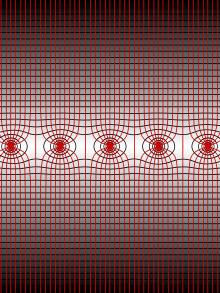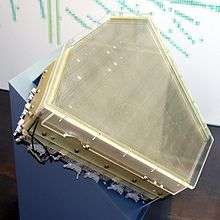Wire chamber
A multi-wire proportional chamber is a type of proportional counter that detects charged particles and photons and can give positional information on their trajectory,[1] by tracking the trails of gaseous ionization.[2]
Description

The multi-wire chamber uses an array of wires at high voltage (anode), which run through a chamber with conductive walls held at ground potential (cathode). Alternatively, the wires may be at ground potential and the cathode held at a high negative voltage; the important thing is that a uniform electric field draws extra electrons or negative ions to the anode wires with little lateral motion.
The chamber is filled with carefully chosen gas, such as an argon/methane mix, such that any ionizing particle that passes through the tube will ionize surrounding gaseous atoms. The resulting ions and electrons are accelerated by the electric field across the chamber, causing a localised cascade of ionization known as a Townsend avalanche. This collects on the nearest wire and results in a charge proportional to the ionisation effect of the detected particle. By computing pulses from all the wires, the particle trajectory can be found.
Adaptions of this basic design are the thin gap, resistive plate and drift chambers. The drift chamber is also sub-divided into ranges of specific use in the chamber designs known as time projection, microstrip gas, and those types of detectors that use silicon.[3][4]
Development
In 1968, Georges Charpak, while at the European Organization for Nuclear Research in CERN, invented and developed the multi-wire proportional chamber (MWPC). This invention drove him to the Nobel Prize in 1992. The chamber was an advancement of the earlier bubble chamber rate of detection of only one or two particles every second to 1000 particle detections every second. The MWPC produced electronic signals from particle detection allowing scientists to examine data via computers.[5][6][7] The multi-wire chamber is a development of the spark chamber.[8]
Fill gases
In a typical experiment, the chamber contains a mixture of these gases:[2]
The chamber could also be filled with:
- liquid xenon;[9]
- liquid tetramethylsilane;[10] or
- tetrakis(dimethylamine)ethylene (TMAE) vapour.[11]

Use
For high energy physics experiments, it is used to observe a particle's path. For a long time, bubble chambers were used for this purpose, but with the improvement of electronics, it became desirable to have a detector with fast electronic read-out. (In bubble chambers, photographic exposures were made and the resulting printed photographs were then examined.) A wire chamber is a chamber with many parallel wires, arranged as a grid and put on high voltage, with the metal casing being on ground potential. As in the Geiger counter, a particle leaves a trace of ions and electrons, which drift toward the case or the nearest wire, respectively. By marking off the wires which had a pulse of current, one can see the particle's path.
The chamber has a very good relative time resolution, good positional accuracy, and a self-triggered operation (Ferbel 1977).[12]
The development of the chamber enabled scientists to study the trajectories of particles with much improved precision, and also for the first time observe and study the rarer interactions that occur through particle interaction.
Drift chambers


If one also precisely measures the timing of the current pulses of the wires and takes into account that the ions need some time to drift to the nearest wire, one can infer the distance at which the particle passed the wire. This greatly increases the accuracy of the path reconstruction and is known as a drift chamber.
The drift chamber functions by balancing the loss of energy from particles caused by impacts with particles of gas, with the accretion of energy created with high-energy electrical fields in use to cause the particle acceleration.[13] Design is similar to the Mw chamber but instead with central layer wires at a greater distance apart.[8] The detection of charged particles within the chamber is possible by the ionizing of particles of gas due to the motion of the charged particle.[14]
The Fermilab detector CDF II contains a drift chamber called the Central Outer Tracker.[15] The chamber contains argon and ethane gas, and wires separated by 3.56 millimetres gaps.[16]
If two drift chambers are used with the wires of one orthogonal to the wires of the other, both orthogonal to the beam direction, a more precise detection of the position is obtained. If an additional simple detector (like the one used in a veto counter) is used to detect, with poor or null positional resolution, the particle at a fixed distance before or after the wires, a tri-dimensional reconstruction can be made and the speed of the particle deducted from the difference in time of the passage of the particle in the different part of the detector. This setup gives us a detector called a Time Projection Chamber (often written just TPC)
For measuring the velocity of the electrons in a gas (drift velocity) there are special drift chambers, Velocity Drift Chambers which measure the drift time for known location of ionisation.
See also
References
- ↑ F. Sauli (1977), - Principles of operation of multiwire proportional and drift chambers Retrieved 2012-02-25
- 1 2 W.Frass. Physics - C4 : Particle Physics Major Option - Particle Detectors (PDF). Oxford University. p. 11. Retrieved 2012-02-25. was located via Dr. C.N. Booth PHY304 Particle Physics Sheffield University
- ↑ I. Kisel - Retrieved 2012-02-28
- ↑ University of Manchester - HEP - 101 Retrieved 2012-02-28
- ↑ Computers in Physics, Sep/Oct 1992 - The Polish Language School for Foreign Students - Adam Mickiewicz University in Poznań - European Organization for Nuclear Research Retrieved 2012-02-25
- ↑ H. Johnston - Physics world Retrieved 2012-02-25
- ↑ "Milestones:CERN Experimental Instrumentation, 1968". IEEE Global History Network. IEEE. Retrieved 4 August 2011. - U.S. Department of Energy Research and Development Accomplishments Retrieved 2012-02-23
- 1 2 Physics. Guildford: University of Surrey. Retrieved 2012-02-28.
- ↑ S.E.Derenzo - SLAC National Accelerator Laboratory, Stanford University ( U.S. Department of Energy Office of Science ); Muller, Richard; Derenzo, Stephen; Smadja, Gerard; Smith, Dennis; Smits, Robert; Zaklad, Haim; Alvarez, Luis (1971). "Liquid-Filled Proportional Counter" (PDF). Phys. Rev. Lett. 27 (8): 532–535. Bibcode:1971PhRvL..27..532M. doi:10.1103/PhysRevLett.27.532. Retrieved 2012-02-28.
- ↑ Degrange, B.; Guillon, J.; Moreau, F.; Nguyen-Khac, U.; De La Taille, C.; Tisserant, S.; Verderi, M. (1992). "Low energy calorimetry in a multiwire chamber filled with tetramethylsilane". Nuclear Instruments and Methods in Physics Research Section A: Accelerators, Spectrometers, Detectors and Associated Equipment. 311 (3): 539. Bibcode:1992NIMPA.311..539D. doi:10.1016/0168-9002(92)90652-K.
- ↑ Schotanus P; Van Eijk CWE; Hollander RW; C.W.E. Van Eijk. "Detection of LaF3:Nd3+ scintillation light in a photosensitive multiwire chamber". Nuclear Instruments and Methods in Physics Research Section A: Accelerators, Spectrometers, Detectors and Associated Equipment. Bibcode:1988NIMPA.272..913S. doi:10.1016/0168-9002(88)90780-2. ; > G. Charpak Research on particle imaging detectors p.537 World Scientific, 1995 Retrieved 2012-02-28
- ↑ T. Ferbel - (CERN report 1977)>
- ↑ F. E. Close; M. Marten; C. Sutton (11 Nov 2004). The particle odyssey: a journey to the heart of the matter. Oxford University Press. ISBN 0-19-860943-4. Retrieved 2012-02-12.
- ↑ W. Blum; W. Riegler; L. Rolandi (4 Oct 2008). Particle detection with drift chambers. Springer. Retrieved 2012-02-28.
- ↑ Kotwal, Ashutosh V; Gerberich, Heather K; Hays, Christopher (2003). "Identification of cosmic rays using drift chamber hit timing". Nuclear Instruments and Methods in Physics Research Section A: Accelerators, Spectrometers, Detectors and Associated Equipment. 506: 110. Bibcode:2003NIMPA.506..110K. doi:10.1016/S0168-9002(03)01371-8. Retrieved 2013-08-05.
- ↑ Fermilab - glossary-photo- J. L. Lee Retrieved 2012-02-12
External links
- hypermail_ archive of links to CLAS drift chambers
- Heidelberg lecture on research ionisation chambers.